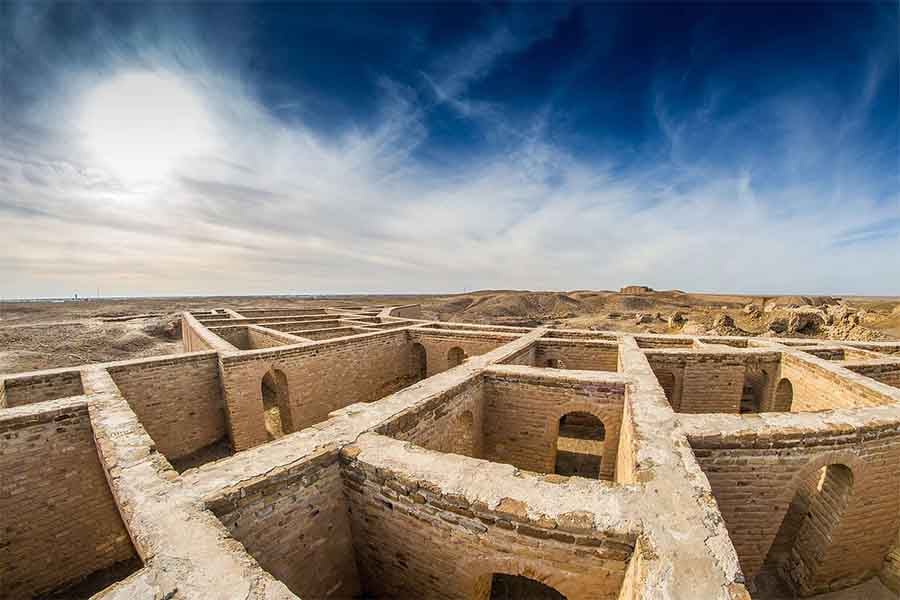Satellite technology reveals hundreds of previously unknown Mesopotamian cities, canals, and roads buried beneath modern landscapes.

What if the origins of civilization are far more complex than we ever imagined? Archaeologist Sarah Parcak is revealing astonishing truths about Mesopotamia, a region once thought to be thoroughly explored.
Utilizing cutting-edge satellite technology, researchers are uncovering vast networks of lost cities, intricate canals, and extensive roads that lie buried beneath the sands of Iraq and Syria—remnants of a civilization long hidden from view.
However, these groundbreaking discoveries come with a dire warning: erosion, looting, and modern expansion are erasing this ancient legacy faster than we can preserve it.
For decades, historians believed that the major archaeological sites of Mesopotamia, often referred to as the “cradle of civilization,” were already known and studied.
Yet, revolutionary satellite images are challenging this notion, revealing a sprawling network of previously undiscovered settlements and infrastructure hidden beneath contemporary farms and urban areas.
These aren’t just isolated ruins; they are ghostly outlines of entire lost cities stretching across the plains, suggesting a level of urban planning and societal complexity that far exceeds previous understandings.

Satellite imagery has unveiled faint geometric patterns etched into the soil—perfectly straight lines, concentric circles, and rectangular grids—that indicate advanced urban development.
To the untrained eye, these may appear as mere color shifts or brown patches, but to satellite archaeologists, they represent the footprints of thriving civilizations.
By employing multispectral and infrared satellite scans, Parcak has detected subtle changes in plant growth and soil moisture, pointing to buried walls and canals that imply a sophisticated infrastructure.
These findings challenge the long-held belief that Mesopotamian cities were merely isolated city-states. Instead, they depict a vast cultural area interconnected by trade and a shared system of water management.
The implications are staggering: the early period of Mesopotamia may have been much more populated and organized than textbooks suggest. Parcak’s extensive studies reveal that the existing historical narrative is merely a fraction of what truly existed.
The sites buried under layers of modern development or natural sediment have concealed these discoveries for centuries, transforming our understanding of the “cradle of civilization” from isolated spots into a continuous, vibrant civilization pulsating beneath the sands.
Some of these lost cities and canals may even predate well-known sites by hundreds of years, raising questions about the established chronologies of urban development in the region.
The satellite data suggests that cities were larger and more intricate than previously assumed, complicating the timeline of humanity’s first urban centers.
The echoes of these vanished cities serve as a reminder that history is an evolving narrative, still unfolding beneath our feet. As researchers trace these outlines from space, they are beginning to uncover chapters of civilization that had gone unnoticed.

Parcak’s pioneering use of satellite imagery has revolutionized archaeological methods. Unlike traditional digs, which require years of excavation at a single site, space archaeology allows researchers to scan vast regions quickly and non-invasively.
By analyzing infrared wavelengths, scientists can detect minute differences in soil moisture and vegetation—clues invisible to the naked eye—that hint at buried structures. This technology has proven invaluable, especially in conflict zones where access is restricted or dangerous.
The advent of space archaeology has transformed the way researchers view cultural landscapes, allowing them to see them as integrated systems rather than isolated sites.
Parcak describes this phenomenon as the “overview effect,” where the interconnectedness of rivers, roads, and settlements becomes apparent.
This perspective shifts the understanding of early Mesopotamia from isolated pockets of civilization to a far-reaching, interconnected society.
However, while satellite technology provides a powerful tool for discovery, ground truthing—physically verifying findings through excavation—is essential for confirming the nature and age of the features revealed by satellites.
The interaction between space and ground work in archaeology today redefines the study of ancient cultures, revealing hundreds of previously hidden sites across Iraq and Syria.
Yet, as these discoveries unfold, they also expose a heartbreaking reality: the very heritage that is being uncovered is under threat.
The same satellite images that reveal lost cities also capture the scars of modern conflict, looting, and urban development that are erasing history layer by layer. Bomb craters, construction pits, and illegal digging mar the landscape, leaving irreversible damage in their wake.
Looting is a pervasive threat driven by the black market demand for antiquities. Desperate treasure hunters dig vast pits, destroying archaeological context even when they fail to recover valuable items.
Satellite data has made it possible to track the spread of these looting pits over time, documenting destruction that often escapes traditional monitoring methods.

Moreover, the region’s political instability has exacerbated these threats. Mesopotamia, once a center of cultural heritage, has been ravaged by conflict, with military operations causing collateral damage to historic sites.
Urban growth and infrastructure development are also significant challenges, as farmland is converted into urban areas, burying traces of ancient civilizations under concrete and asphalt.
Parcak’s urgent call to action highlights the irony that the technology uncovering Mesopotamia’s history is also documenting its demise.
While satellite monitoring aids in preserving this cultural heritage, it is only a starting point. The loss of each site represents a unique opportunity to understand our origins slipping away.
As the destruction intensifies, the race to unearth, document, and protect Mesopotamia’s heritage becomes increasingly urgent.
The canals and cities revealed from space tell a story of ingenuity and resilience, but the threats they face remind us that history hangs in a delicate balance, demanding both awe and vigilance.
Sarah Parcak’s groundbreaking discoveries challenge us to rethink the origins of civilization. The evidence suggests that early societies were not isolated but instead engaged in sustained cooperation and cultural exchange.
The narrative of Mesopotamia is evolving, revealing a complex tapestry of overlapping cultures and innovations. As we delve deeper into this hidden world, we are reminded that much of our history remains vulnerable and waiting to be uncovered.



